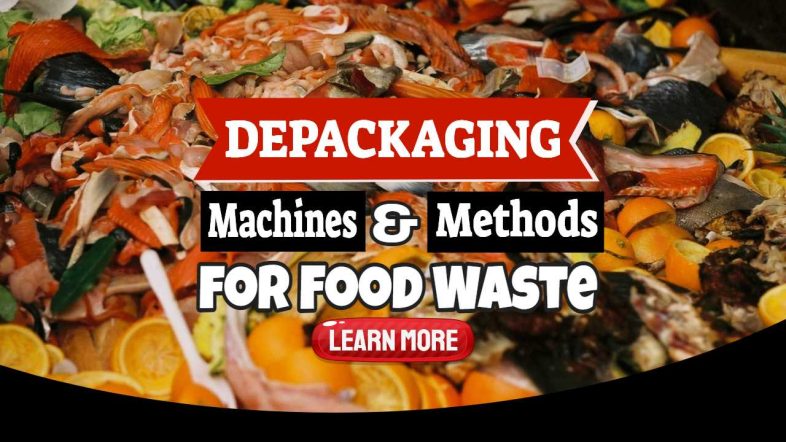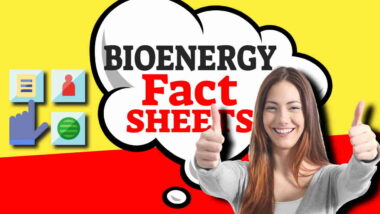Depackagers, also known as depackaging machines, are devices that assist in the automated unpacking or depacking of goods and materials such as food waste.
Cans, bottles, and other containers can be unpacked, depackaged, and sorted into separate factions as organic soup, rejects, inerts, and recyclable.
Using depackaging technology with separators the recyclables in the rejects, such as plastic, are further sorted and recycled.
Sophisticated Depackaging
The most sophisticated of these machines can also handle food containers, such as plastic containers, cans, and bottles that have not been opened and are either full or partially full of food.
Depackaging machines can be found in a wide range of industries. A food manufacturer, for example, may use a depacker to sort and repack canned fruits and vegetables that are out of specification due to a minor reason, such as a labelling error, for further transport and sale to grocery stores.
Optimising the waste depackaging process is critical in ensuring that suitable putrescible waste material is delivered to anaerobic digestion plants, as well as in repurposing it to be fed to livestock. Separated packaging can then be sent to a recycling facility, resulting in even more waste reduction and the potential for additional revenue streams.
Equipment for Depackaging
A network of anaerobic digestion and composting facilities located throughout the United Kingdom collaborates with supermarkets, food manufacturing businesses, waste management companies, and local governments to recycle food, garden waste, and other organic waste using this equipment.
A paper product manufacturer may use a depackaging device to sort and repack paper products for sale after cutting for resizing or reprinting. Warehouses that take back clothes that were found to be an incorrect size can also use depackaging machines. Some models of these machines can also unpack, re-test, sort, and repack returned goods such as appliances for resale.
Many different manufacturers produce depackaging machinery. Some of these machines are designed to handle only one type of product, whereas others are designed to handle a variety of products, particularly plastic containers. Many depackaging machines are made to order to meet the needs of individual customers. If you need a depacker, you should contact a company that specialises in this type of equipment. On the internet, you can find information about depackaging machinery.
Depackaging curbside, recycled, and bin waste is critical to achieving energy recovery from the municipal waste generated by councils. Energy recovery is the conversion of non-recyclable waste materials and packaging into usable energy such as heat, electricity, or fuel. It can be accomplished through a variety of processes such as combustion, gasification, pyrolysis, anaerobic digestion, and landfill gas recovery, amongst other things.
Feeding from a Hopper
MOW (municipal organic waste). and the composition of OFMSW varies significantly from one municipality to another, it also changes seasonally so hoppers are best when fitted with contra-rotating augers to stop bridging.
A depackaging machine will have a hopper that holds a supply of the item to be removed from its packaging. In the case of food waste, you will want to separate the food residues from the packaging, leaving the packaging materials clean for re-use and recycling. The item will then be removed from the hopper and placed in a bin by the machine.
Once the item has been placed in the bin, the machine will remove it and place it back into its original packaging. After that, the item will be shipped to the customer.
Methods of Depackaging
Many depackaging machines differ significantly from one another and from the original packing machines. They are, however, frequently customised to meet a specific need. Some, for example, are intended to handle a specific type of item. Other depackaging machines are tailored to a specific industry. A company that manufactures paper products, for example, may require a paper-specific unpackaging machine.
If you want to buy a depackaging machine, you should contact a company that specialises in depackaging machinery. You might want to look for one online. This allows you to learn more about these depackers and see which models are available.
Separators of Food Waste – And Depackaging Systems
Food waste separators and depackaging systems are critical for recycling packaging materials efficiently.
Recycling is one of the methods that many people have cited as a solution to many of the environmental issues that have come up in recent years. Recycling has been around for a long time, but it has only recently gained popularity with the advent of the internet and the realisation of how much damage we as a species are doing to the environment.
Recycling is a simple concept, but it can be difficult to put into practise. It is critical to remember that recycling is about more than just the material itself. Recycling should include the packaging that surrounds the material being recycled in order to be truly effective. This is due to the fact that the packaging is what will ultimately end up in the trash. Recycling should not be a last-minute consideration. It should be regarded as the first step.
Separators for Organic Waste
Food waste separators are intended to assist with this issue. Food waste separators separate materials that would otherwise go into the garbage into different components. These parts can then be recycled independently. A food waste separator can separate meat, dairy, vegetables, fruits, bones, and other food components.
Another type of recycling equipment that can be used to separate food waste into its individual components is depackaging systems. This machine takes it and separates it into its constituent parts. Durable packaging, such as jam jars packed in plastic containers inside a cardboard box, will be completely depackaged.
When waste cannot be separated by hand, depackaging systems come in handy. For instance, if the waste is too large or difficult to break down. Separated packaging can then be recycled, reducing waste and potentially adding new revenue streams.
Food Depackaging Machinery
Food depackaging equipment is similar to depackaging systems, but it is specifically designed to handle food waste packaging. When delivered Source Separated Organics (SSO), this equipment can separate the food waste from the packaging, and the best can also accept and process non-source-segregated OFMSW. There are several types of depackaging equipment available. Some of this equipment is intended for specific types of packaging, such as glass jars. Others are intended for use with all types of packaging, such as plastic.
Food Waste Depackaging Equipment Applications
Food waste depackaging equipment can be used in a variety of applications. It can be used in a variety of applications at AD Plants and composting facilities.
It can be used in a variety of ways, including:
- Separation of food waste from packaging
- Separating the recyclable materials from the separated packaging
- Sorting recyclable materials from one another
- Separating the organic from the inert components.
Food waste depackaging equipment is an excellent method of recycling food waste. It is critical to remember that the equipment must be used properly. Before using the equipment again, it should be thoroughly cleaned. This will ensure that it functions properly and lasts longer.
Using Technology to Aid in the Reduction of Food Waste
The term “technology” is used in a variety of contexts. I’ll use it as an example of how we can use technology to make our lives easier and more efficient in this article.
In the following sections, I will discuss how technology can help us with our food waste problems, both from source-separated organics (SSO) and when mixed, as in MOW (municipal organic waste).
The term “food waste” refers to all food that is thrown away by consumers, but it also includes food that is not consumed at home but is discarded by the food industry.
When you buy a garment, for example, it comes in its own packaging. This packaging typically consists of plastic bags containing the garment as well as other items such as a hanger, clear plastic film, and a cardboard box. Separated into separate output streams these items are then sold to individuals who resell them to recycled materials manufacturers.
For example, animal feed companies take out of specification food products debag and sort the contents and then recombine these items in a balanced-diet nutrient feedstuff and sell it to farmers who feed the newly reformulated food to their animals.
Food waste is a major issue because unless used in some way, it takes up valuable landfill space. Landfills are becoming overcrowded, and there is only so much space available in the world’s landfills.
Dominator De-Sale Unit
The Dominator De-Sale Unit divides outside packaging from interior waste to allow the recycling of wastes that are otherwise sent directly to landfills. Food waste continues to grow in importance to businesses, councils and companies in general.
Some of the generated materials can be accepted directly into the manufacturing process, but the material will, however, require separation from the outside packaging before processing the product.
This process helps get food waste into anaerobic digestion facilities and is used in feeding animals for consumption.
Biogen turned to Tiger DePack for its food waste depackaging
Article from Bioenergy Insight January 2018. Richard Nuttall is Chief Productivity Officer at Biogen. He began working for the business on construction projects as part of the company in 2013. Richard currently oversees all business procurement activity with a responsibility to review and agree the contract arrangements with Biogen. Biogen has 13 aerated digesting plants and six composting plants located in the UK.
The term “Tiger depack” is one way that technology can help solve the problem of food waste. This term refers to a system that allows food to be separated from its packaging and delivered to various locations for use. In the Tiger Depackager any clean, dry packaging (inorganic) material is extracted using an auger system, which does not require any secondary processing or handling in order for it to be recycled or repurposed.
There are several types of food waste separators and the Tiger depack is just one of many. Some are intended for use in industrial settings. Those designed to handle large amounts of packaged food waste have been greatly improved, and the third generation now available can be far more efficient than previous versions.
Other systems are intended for use at home. They are intended for use with small amounts of food waste. Typically, these systems consist of a tray that sits on top of your kitchen sink. You put your food waste in the tray, and the tray separates the food from the packaging. The food is thrown away, and the packaging is poured down the sink drain.
Tiger DePack
The Tiger depack depackaging system is another type of system. This system is based on the same concept as the food waste separator. Its purpose is to separate food from packaging. It is, however, intended for use in smaller quantities than the food waste separator. You can easily manage the complete operation of the Tiger Depack with simple buttons and touch screen controls (remote control available).
Machines such as the Tiger DePack process primarily packaged food waste from a wide range of sources, including industrial and commercial waste streams. Restaurants, food producers, and supermarkets are among the sources of food waste, as are household streams where food waste is collected at the curbside.
Drycake’s Twister
Drycake’s Twister depackaging and separator system is a final type of system. It does all this and more. This system is based on the idea that a depack system should be as simple and as integrated as possible, and that it should not smash the material into tiny particles as much as possible. It is intended for more than just large amounts of food waste. It is intended for use in restaurants and other settings where large amounts of food are wasted. Before feeding material into the digesters, an auger system can be useful for moving break open bags in the feed hopper. See the YouTube Drycake™ Twister Depackager Products Videos here.
Food waste can be reduced with the help of technology. The three types of systems mentioned above are just a few examples of how technology can assist.
The following is the source of the featured image’s background: By https://secure.flickr.com/photos/sporkist/126526910, CC BY 2.0, Link





